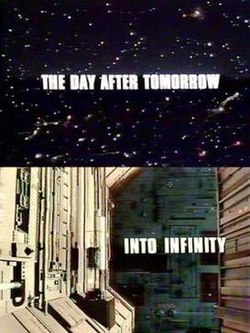The Day After Tomorrow (TV special)
| The Day After Tomorrow | |
|---|---|

Opening titles, featuring "Into Infinity" subtitle
|
|
| Also known as | 'Into Infinity' |
| Genre | Science fiction |
| Created by |
Gerry Anderson Johnny Byrne |
| Written by | Johnny Byrne |
| Directed by | Charles Crichton |
| Starring |
Brian Blessed Joanna Dunham Nick Tate Katherine Levy Martin Lev Don Fellows |
| Narrated by | Ed Bishop |
| Composer(s) |
Derek Wadsworth Steve Coe |
| Country of origin | United Kingdom |
| Original language(s) | English |
| Production | |
| Producer(s) | Gerry Anderson |
| Cinematography | Frank Watts |
| Editor(s) | David Lane |
| Running time | 47 minutes |
| Production company(s) | Gerry Anderson Productions |
| Distributor | NBC |
| Release | |
| Original network | NBC (United States) BBC1 (United Kingdom) |
| Audio format | Mono |
| First shown in | United States |
| Original release | 9 December 1975 (US) 11 December 1976 (UK) |
The Day After Tomorrow (also known as Into Infinity in the United Kingdom) is a 1975 British science-fiction television drama produced by Gerry Anderson between the first and second series of Space: 1999. Written by Johnny Byrne and directed by Charles Crichton, it stars Brian Blessed, Joanna Dunham and Nick Tate and is narrated by Ed Bishop. The Day After Tomorrow first aired in December 1975 in the United States on NBC, as an episode of an occasional series of after school specials for children, Special Treat. In the UK, it was broadcast on BBC1 as a TV special in December 1976 and December 1977; 37 years later, in November 2014, a revised version was broadcast on BBC Four. The plot of The Day After Tomorrow concerns the interstellar mission of Altares, a science vessel of the future that can travel at the speed of light. From its initial destination of Alpha Centauri, the ship pushes deeper into space; there, her crew of three adults and two children encounter such phenomena as a meteor shower, a red giant and, finally, a black hole, which pulls the ship into another universe.
Originally commissioned to create a child-friendly introduction to Albert Einstein's special relativity theory in the form of an exciting action-adventure, Anderson and Byrne conceived The Day After Tomorrow as a television pilot for a potential series and gave it an alternative episode title of "Into Infinity". Ultimately, Anderson's limited budget prevented additional episodes from being made. With a cast and crew including veterans of earlier Anderson productions, filming on The Day After Tomorrow ran from July to September 1975; this comprised ten days of principal photography and six weeks of special effects shooting. The visuals of Space: 1999 provided inspiration for both Martin Bower, who designed the scale model effects for the special, and production designer Reg Hill, who re-used set elements created for various episodes of that series to build the interiors of Altares. Newcomer Derek Wadsworth collaborated with Steve Coe to compose the theme and incidental music.
...
Wikipedia
